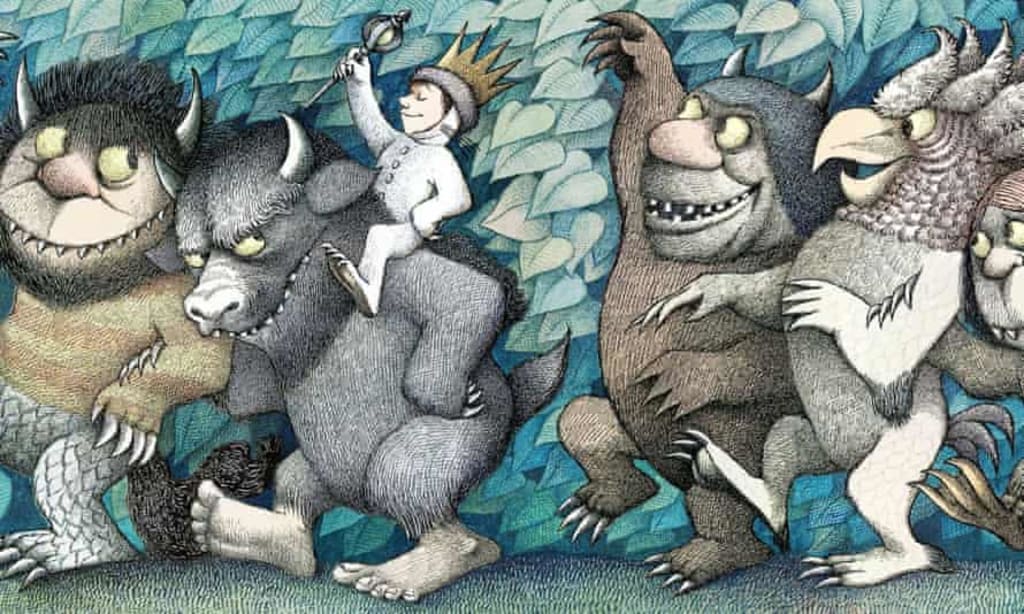"Wild" read which never gets old
Trippy illustrations and a powerful message of family

There was and still is something deliciously trippy about Maurice Sendak's "Where the Wild Things Are".
I don't know which is crazier -- the storyline about a little boy, Max, who is sent to his room and sails away to an island full of weird and wonderful creatures where he is subsequently anointed King -- or the illustrations themselves, all muted and sepia 1960s colors, grotesque and a tad frightening.
I was only about five when I was given this book by my parents and I was instantly entranced by the motley crew of "Wild Things" as well as the naughty little boy.
The fascinating monsters with scales and feathers in an array of colors were borne out of Sendak's wonderfully fertile imagination and seemed so terrifying yet friendly at the same time. After all, Max is easily able to subdue and subordinate them to his will.
I guess I could relate to the tantrum-prone Max but just checking Wikipedia, I see the book was actually published in 1963, about seven years before it landed on my little wooden bookshelf.
Sadly, it seems Sendak (1928-2012) wrote the book in part after seeing his parents repeatedly traumatized by news of the decimation of extended family members in the Holocaust.
The Sendaks, working-class Polish-Jews living in Brooklyn, must have wrestled with an agonizing mix of grief and survivor's guilt as each new death was discovered following the liberation of the concentration camps during and after World War II.
Sendak himself was a sickly child and spent a lot of his early years confined to bed. This is when he discovered a love for books and reading which would later become his life's work.
Illustrating books and in particular, writing "Where the Wild Things Are", was almost therapeutic for Sendak, keen to impart to children a message of the fragility of family and the importance of never taking loved ones for granted.
I loved the book because it was like nothing else I had ever seen. Interestingly, it seems the book received negative reviews when it was first published with many librarians and teachers deeming it unsuitable for children.
But after a couple of years of children repeatedly checking it out of libraries, the "grown-ups" relented and twigged to what a truly brilliant book it was in its encapsulation of child anger and rebellion.
It had sold more than 19 million copies worldwide as at 2009 with 10 million of these bought in the United States alone.
It was also adapted to film in 1973 and again in 2009 when Warner Bros. released a $100 million movie directed by Spike Jonze and produced by Sendak himself and actor Tom Hanks among others.
I saw the film with my youngest daughter and her best friend and the girl's big brother who would have been about nine at the time.
To my dismay, the poor little guy burst into tears during the pivotal scene when Max realizes he misses his mum. He didn't stop sobbing actually making for a somewhat awkward conversation with his parents when I dropped him home. Oh well...
As good as the movie was, it didn't even come close to the genius of the book.
At just 338 words in total, it perfectly tapped into children's frustration and innate struggle between "being good" and "being wild".
It was always my go-to for a bedtime story to be read to me or for me to read to myself as I grew older.
The audacity of Max, packing up and leaving home after his mother sends him to his room without any supper, was exceedingly admirable.
The whole "turning on and dropping out" movement was in full swing in 1970 on Sydney's northern beaches. Hippies surfed, openly smoked weed, made daisy chains and walked Afghan dogs.
Even at age five, I secretly admired their flowing clothes, long shiny hair and bare feet not to mention the exciting music wafting down from bungalows lining the water's edge.
They seemed gentle, at peace and unhurried unlike my own parents who were perpetually busy.
The book matched the times. It was about hitting the road, snubbing authority and expressing oneself.
But, unlike the hippies on the beach outside my window, Max soon tires of his newfound freedom and returns home to his cozy, little bed and ... surprise, surprise ... a lovely, hot supper waiting for him. The supper represents love and forgiveness because remember he had earlier been sent to his room without supper as punishment for his wreaking havoc throughout the house.
Reading between the lines, even as a child, I realized the supper was a kind of peace offering from a frustrated parent who had since had time to reflect and remember that Max was only a little boy acting out which is what kids do.
I just couldn't get enough of this story and insisted it be read to me every night before bed. Max was such a rebel and I was intrigued by his courageous voyage to the secluded island where he meets his new, monstrous family.
He gets to swing in the trees and march on the beach and do whatever he wants to do whenever he wants to do it without any pesky parents spoiling his fun.
I wished I could do the same thing myself.
Over time, my copy of "Where The Wild Things Are" became bent out of shape and tattered with so many repeat reads and was always the first book I packed when we moved house over and over again.
It was ever so slightly water-stained after surviving a cyclone, as I did, in Darwin in 1974, then frayed at the edges by my younger siblings trying to steal it away from me.
Many years later, I bought the book for my own children and they fell in love with it just as I had almost 30 years earlier. I hope to one day read it to my grandchildren. It's a story which never gets old.
About the Creator
Shirley Twist
Shirley has had a 35-year career as a journalist, editor and teacher. She has been story-writing since she was 5 and her first story was published at age 13. A University of Western Australia graduate, Shirley is married with 2 children






Comments
There are no comments for this story
Be the first to respond and start the conversation.